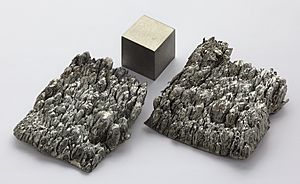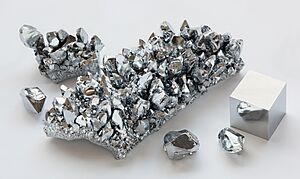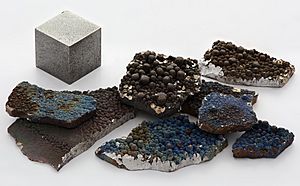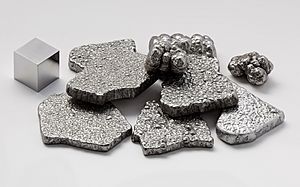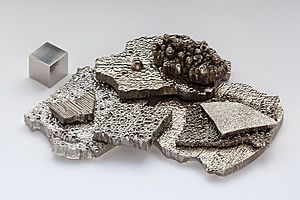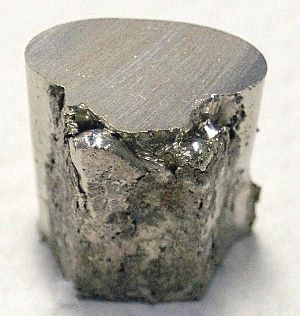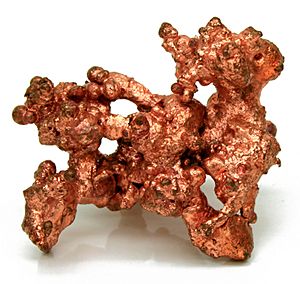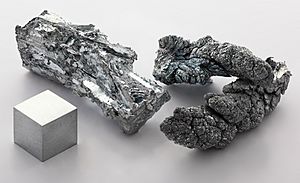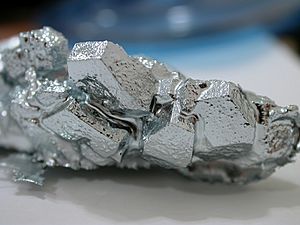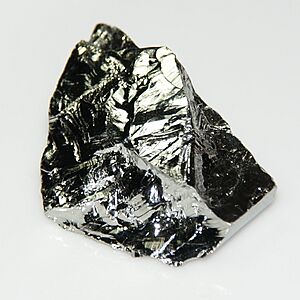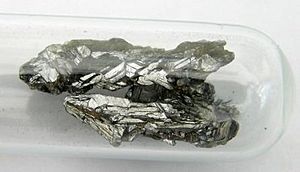Period 4 element facts for kids
A period 4 element is a chemical element found in the fourth row, or period, of the periodic table. This row starts with potassium and ends with krypton. These elements have different properties and are used in many ways.
Contents
- Elements That React Easily (s-block)
- Transition Metals (d-block)
- Scandium: A Rare Find
- Titanium: Strong and Light
- Vanadium: Corrosion Fighter
- Chromium: Colorful and Shiny
- Manganese: Protecting Iron
- Iron: The Earth's Common Metal
- Cobalt: Blue and Magnetic
- Nickel: From Space to Your Core
- Copper: An Ancient and Essential Metal
- Zinc: Important for Health and Batteries
- Other Elements (p-block)
- See also
Elements That React Easily (s-block)
Potassium: A Very Reactive Metal
Potassium (K) is an alkali metal. It sits below sodium and above rubidium on the periodic table. It's the first element in period 4. Potassium is one of the most reactive elements. This means it easily combines with other substances. Because of this, you usually only find it as part of compounds.
When fresh, potassium looks silvery. But it quickly reacts with oxygen in the air and loses its shine. It's soft enough to cut with a knife. Potassium is also one of the lightest elements for its size. It has a low melting point, meaning it melts easily, even with a small flame. It's also lighter than water, so it can float!
Calcium: Building Bones and More
Calcium (Ca) is the second element in period 4. It is an alkaline earth metal. Calcium is very reactive with water, so you almost never find it pure in nature.
Calcium has a very important job in all animals and some plants. It helps build strong bones and teeth. It's also used inside cells to send signals for different cellular processes. Calcium is the most common mineral found in the human body.
Transition Metals (d-block)
Scandium: A Rare Find
Scandium (Sc) is the third element in period 4. It is the first transition metal on the periodic table. Scandium is quite common in nature. However, it's hard to find because it's mostly in rare earth compounds. It's difficult to separate scandium from these compounds.
Because it's hard to get, scandium isn't used much in products. Its main use is in aluminium alloys. Alloys are mixtures of metals.
Titanium: Strong and Light
Titanium (Ti) is another element in period 4. It is one of the lightest metals. It is also one of the strongest and most resistant to corrosion. This means it doesn't rust or get damaged easily.
Because of these amazing features, titanium is used in many things. It's often mixed with other elements to make strong alloys. You can find titanium in airplanes, golf clubs, and other items that need to be strong but lightweight.
Vanadium: Corrosion Fighter
Vanadium (V) is an element in period 4. You never find pure vanadium in nature. It is always found in compounds. Vanadium is like titanium because it resists corrosion very well. However, unlike titanium, it reacts with air even at room temperature.
All vanadium compounds are at least a little bit toxic. Some of them are very poisonous.
Chromium: Colorful and Shiny
Chromium (Cr) is an element in period 4. Like titanium and vanadium, it is very resistant to corrosion. In fact, it's a main part of stainless steel, which doesn't rust.
Chromium also forms many colorful compounds. Because of this, it's often used in pigments, which are colors for paint. An example is chrome green.
Manganese: Protecting Iron
Manganese (Mn) is an element in period 4. You can often find manganese by itself in nature. It is also found mixed with iron. Like chromium, manganese is an important part of stainless steel. It helps stop iron from rusting.
Manganese is also used in pigments, just like chromium. But be careful: manganese is poisonous. If you breathe in too much, it can cause lasting damage to your brain and nerves.
Iron: The Earth's Common Metal
Iron (Fe) is an element in period 4. It is probably the most famous element in this period. Iron is the most common element on Earth. It is also a major part of steel.
A special version of iron, Iron-56, is very stable. This means it's the heaviest element that can be made inside huge supergiant stars. Iron also has important jobs in the human body. For example, hemoglobin, which carries oxygen in your blood, contains iron.
Cobalt: Blue and Magnetic
Cobalt (Co) is an element in period 4. Many cobalt compounds are blue. This makes cobalt a common choice for pigments. Cobalt is also a key part of many strong and magnetic metal mixtures.
The only stable type of cobalt, cobalt-59, is important for vitamin B-12 in your body. However, another type, cobalt-60, is radioactive. It can be dangerous in large amounts.
Nickel: From Space to Your Core
Nickel (Ni) is an element in period 4. It's not very common in the Earth's outer layer. This is because it reacts with oxygen in the air. Most nickel on Earth comes from nickel iron meteorites that fall from space.
However, nickel is very common deep inside the Earth. Along with iron, it's one of the two main parts of the Earth's core. Nickel is also an important part of stainless steel and many superalloys, which are very strong metal mixtures.
Copper: An Ancient and Essential Metal
Copper (Cu) is an element in period 4. It's one of the few metals that isn't white or gray. The only others are gold and caesium. Humans have used copper for thousands of years. It gives a reddish color to many objects.
Copper is also an essential nutrient for humans. But too much copper can be poisonous. It's also often used to protect wood or as a fungicide, which kills fungi.
Zinc: Important for Health and Batteries
Zinc (Zn) is an element in period 4. It is one of the main parts of brass, a metal mixture used since ancient times. Zinc is incredibly important for humans. Almost 2 billion people around the world don't get enough zinc. However, too much zinc can cause a lack of copper in the body.
Zinc is often used in batteries, like carbon-zinc batteries. It's also important in many metal coatings because zinc resists corrosion very well.
Other Elements (p-block)
Gallium: Melts in Your Hand
Gallium (Ga) is an element in period 4. It's special because its melting point is around 303 kelvins. This is very close to room temperature. So, it might be solid on a cool day but liquid on a hot summer day!
Gallium is an important part of the alloy galinstan, along with tin. It can also be found in semiconductors, which are materials that can conduct electricity under certain conditions.
Germanium: A Useful Semiconductor
Germanium (Ge) is an element in period 4. Like silicon above it, germanium is an important semiconductor. It's often used in electronic parts like diodes and transistors, sometimes with arsenic.
Germanium is quite rare on Earth. This is why it was discovered later than many other elements. Some germanium compounds can irritate your eyes, skin, or lungs.
Arsenic: Poisonous but Useful
Arsenic (As) is an element in period 4. As mentioned, it's often used in semiconductors when mixed with germanium. Pure arsenic and some of its mixtures are very poisonous to all living things made of many cells. Because of this, it's a common part of pesticides, which kill pests.
Arsenic was also used in some colors for paint before people found out how poisonous it was.
Selenium: A Trace Element
Selenium (Se) is an element in period 4. It is the first nonmetal in this period. It has properties similar to sulfur. Pure selenium is quite rare in nature. You mostly find it in minerals like pyrite, and even then, it's not very common.
Humans need tiny amounts of selenium to stay healthy. But in larger amounts, it can be poisonous.
Bromine: A Liquid Halogen
Bromine (Br) is an element in period 4. It is a halogen, which means it's a very reactive element. You never find pure bromine in nature. Bromine is barely liquid at room temperature. It boils at about 330 kelvins.
Bromine is also quite poisonous and can damage things it touches. However, bromide ions, which are less reactive, can be found in halite, or table salt. Bromine is often used as a fire retardant. This is because many of its compounds can release bromine atoms that stop fires.
Krypton: The Noble Gas
Krypton (Kr) is a noble gas. It is found below argon and above xenon. Noble gases like krypton rarely react with themselves or other elements. Even though some compounds have been found, they are not stable and break down quickly.
Because it doesn't react much, krypton is often used in fluorescent lights. Like most noble gases, it's also used in lighting because it gives off many special colors of light.
See also
 In Spanish: Elementos del periodo 4 para niños
In Spanish: Elementos del periodo 4 para niños




